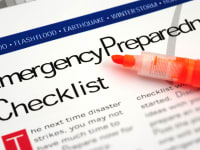Products are chosen independently by our editors. Purchases made through our links may earn us a commission.
Earlier this week, Mississippi Governor Tate Reeves declared a state of emergency following heavy rainfall that caused flooding and a water treatment plant failure in the Jackson area. With climate change leading to more frequent and severe extreme weather events such as heavy rain and hurricanes, it’s more important than ever to know how to acquire safe, uncontaminated drinking water when an emergency strikes. Not sure where to start? Here’s what to know about storing, disinfecting, and finding safe drinking water during an emergency.
Is tap water safe to drink?
Yes, it is safe to drink tap water in an emergency, as long as there are no drinking water advisories in your area. If there is an advisory, you should be aware of what each one means. A “boil water advisory” means that water is safe to drink and use for cooking as long as it has been boiled, as it may contain contaminants that can otherwise make you sick. A “do not drink” advisory means that you are advised to not use your tap water for drinking, cooking or any other activity wherein water may be easily ingested. Finally, in the event of a “do not use” advisory, tap water should not be used for any purpose, including bathing.
You can learn about potential water advisories in your area with a radio or through the web. If you’re unable to find out if there’s a water advisory and you have reason to believe there could be one, it’s best to exercise caution and forego using tap water until you are certain it’s safe to do so.
The Environmental Protection Agency (EPA) has established several guidelines and standards for the United States water supply that protect the quality of the water that we use and drink. There are over 148,000 EPA-regulated public water systems that are required to provide safe drinking water to Americans. Because of this, tap water is comparable to bottled water in terms of safety.
Is rainwater safe to drink?
While rainwater may seem like a viable option when water access is limited, the CDC warns against assuming rainwater is safe to drink. Rainwater may contain contaminants like bacteria, viruses, parasites, and chemicals.
While rain barrels are great for reducing stormwater runoff and for non-potable use, they do not provide protection against these contaminants, and shouldn’t be used for drinking water use—even during an emergency.
Additionally, rainwater cisterns are popular storage methods for collected rainwater used across the globe. But even if the cisterns are constructed and used properly, the CDC says that contamination can easily occur.
With this in mind, it’s best to avoid drinking rainwater and look for alternative water sources.
Is well water safe to drink?
Many homes have access to private water wells, an individual system that uses groundwater to provide water directly to the home. Each well water system is privately owned and regulated, so homeowners are responsible for taking charge by having their water tested annually.
While tap water is tested and treated by the EPA regularly, well water is not, so the potential for contamination is high.
Sources of contamination can include microorganisms like viruses and parasites, nitrate (present in fertilizers and sewage), heavy metals, excess fluoride, and more.
If your well water source has not been regularly tested, it may not be safe to drink. If the private well water is at significant risk of contamination due to a natural disaster or emergency, the EPA recommends erring on the side of caution and avoiding drinking from and washing with the water until you can get it tested.
After heavy rain such as that seen in Mississippi, it will be more important than ever to check your well for contamination.
Bottled water is the best option in emergencies
In an emergency, you should drink any water bottles that you already have in your home first. The CDC says that bottled water is the safest and most reliable source of water during an emergency situation.
The FDA regulates treated bottled water on the market—including distilled water, mineral water, spring water, reverse osmosis water, and others—to ensure it’s safe to drink.
What to know about buying bottled water
All bottled water regulated by the FDA is safe for most individuals. However, the CDC recommends that those with compromised immune systems carefully read water bottle labels to know what treatment processes the brand uses. Certain filtering processes may not effectively filter our specific parasites like cryptosporidium or “crypto,” which can be especially dangerous for those with weakened immune systems.
Look for one of the following types of treatments on the bottle’s label:
- Reverse osmosis treated
- Distilled
- Filter through an absolute 1 micron filter
Can you drink expired bottled water?
Bottled water can come with an expiration date. And while the FDA does not require an expiration date to be printed on water bottles, experts question if water—or the bottles themselves—can in fact expire.
Many studies show that plastic from bottled water can leach into the water, especially when exposed to extreme temperatures. However, there is no current legislation requiring or recommending any expiration dates.
We can’t recommend either drinking or avoiding old water you’ve had stored—however, we can recommend safe water storage practices.
How to safely store water
Storing enough water for you and your family is essential during an emergency. Unless instructed to do so by the authorities, don't ration water. Instead, drink as much as you would need in a typical day to avoid dehydration. The CDC recommends storing at least one gallon of water per person, per day, for three days—this will be used for both drinking and sanitization. If possible, try to store a two-week supply of water.
For store-bought water, the CDC also recommends looking out out for expiration dates (if the water comes with one).
If you’re storing water that isn’t commercially bottled, Ready.gov says to store water in food-grade water storage containers that are washed or sanitized before using. Replace all non-store-bought water every six months.
Keep stored water out of direct sunlight and in a room with a cooler temperature if possible. In addition, do not store water in areas where toxic substances, like gasoline or pesticides, are present.
How to make potable water
If an emergency strikes and you have no bottled water or stored water that’s safe to drink, you can make potable water—aka safe-to-drink water—at home.
To ensure your water is safe to drink, use a pot to bring water to a full rolling boil for one minute (or three minutes if you live at an elevation above 6,500 feet), then allow it to cool down before using. To improve the flat taste you may get from boiled water, the EPA recommends adding a pinch of salt to each quart or liter of water.
Additionally, you can disinfect water by very carefully and precisely using household bleach. Be sure to follow the EPA’s disinfection guidance for the amount of bleach and the type of bleach you can add to the water. (It’s not a lot. For example, a gallon needs only six to eight drops.) Once added, stir and let stand for 30 minutes—the water should have a slight chlorine odor, according to the EPA.
There are several other disinfection methods made available by the EPA—including the use of water disinfection tablets—that you can read up on for more options during an emergency.
Why you should avoid non-potable water
Non-potable water—or water that is not suitable for consumption—may contain a number of contaminants. According to the EPA, unsafe levels of contaminants can cause health risks like gastrointestinal illness, nervous system issues, chronic diseases like cancer, and other health problems.
If you consume non-potable water, you may have also consumed harmful contaminants. Short-term exposure may result in gastrointestinal illness which can include diarrhea, vomiting, and cramps.
You may also come into contact with disease-causing contaminants and microorganisms—some of the most frequent causes of contamination include Giardia, Legionella, and norovirus, among many others. Some contaminants can lead to long-term or serious complications like lung failure or death, as seen with Legionnaires’ disease, for example, which is caused by Legionella bacteria.
If you found out you drank non-potable water, you may want to contact local authorities to learn what kind of contaminants are present in the water.



